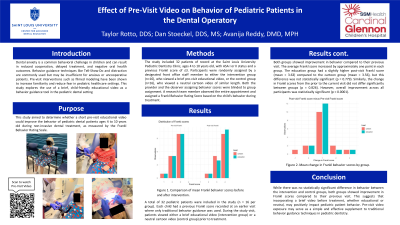Patient Management
308 - Effect of Pre-visit Video on Behavior of Pediatric Patient’s in the Dental Operatory


Taylor Rotto, DDS
Pediatric Dental Resident
Saint Louis University Pediatric Dentistry
Saint Louis University
Richmond Heights, Missouri, United States- DS
Daniel Stoeckel, DDS, MS
Program Director
Saint Louis University
St. Louis, Missouri, United States
Presenting Author(s)
Program Director(s)
Effect of Pre-visit Video on Behavior of Pediatric Patient’s in the Dental Operatory
Purpose: This study aims to assess whether a short pre-visit educational video can improve the behavior of pediatric dental patients ages 4 to 10 years old during non-invasive dental treatment as measured by the Frankl Behavior Rating Scale.
Methods: This study was conducted at the Saint Louis University Pediatric Dentistry Clinic, involving children ages 4 to 10 years old with an ASA I or II health status and a Frankl score of < 3 at their most recent visit. The study included 32 patients of record at the Saint Louis University Pediatric Dentistry. Participants were randomly assigned by a designated front office staff member to either the intervention group (n=16), who viewed a brief pre-visit educational video, or the control group (n=16), who viewed a neutral cartoon video of similar length. Participants in the intervention group watched a short video in the waiting room that introduced the dentist, instruments, and procedures to be expected in a child-friendly manner. Both the provider and the observer assigning behavior scores were blinded to group assignment. A calibrated research team member observed the entire appointment and assigned a Frankl Behavior Rating Score based on the child's behavior during treatment.
Results: A total of 32 patients were included (n = 16 per group). Pre-visit Frankl scores were obtained from each patient’s most recent appointment, during which no video intervention was used. During the study visit, patients viewed either an educational dental video (intervention group) or a neutral cartoon video (control group) before treatment. Both groups showed improved behavior, with an average increase of approximately one Frankl level. The post-visit mean Frankl scores were 3.63 (intervention) and 3.56 (control); this difference was not statistically significant (p = 0.779). Similarly, the change in Frankl scores did not significantly differ between groups (p = 0.826). However, a one-sample t-test showed that the overall improvement in behavior from prior to current visit was statistically significant (p < 0.0001).
Conclusions: Although no statistically significant difference was observed between the intervention and control groups, both groups demonstrated improved behavior following pre-appointment video exposure. These findings suggest that brief video interventions, even if not specific to dentistry, may have a positive influence on pediatric dental patient behavior and could serve as a useful addition to existing behavior guidance strategies.
Identify Supporting Agency and Grant Number:

.jpg)